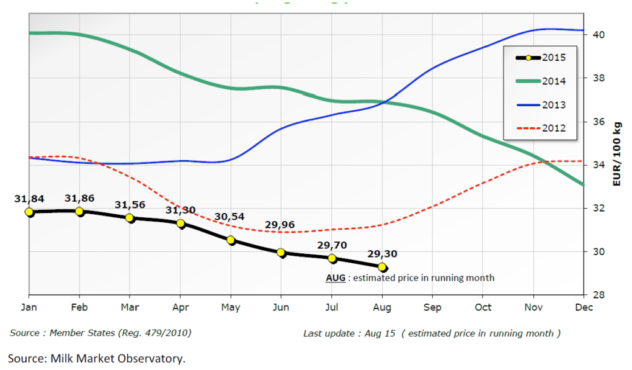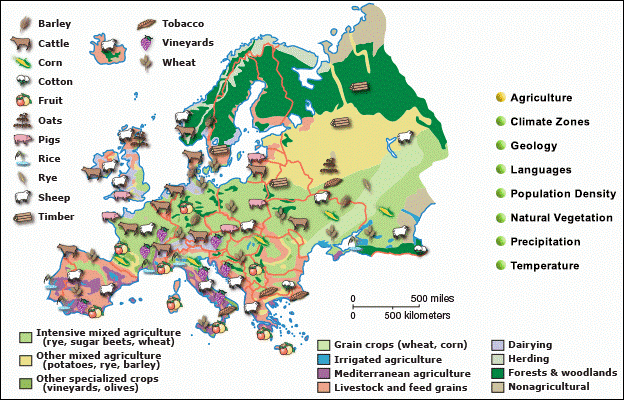Common Agricultural Policy and the European agriculture crisis
By Noémie Nohara, Masters Graduate from Polytech Paris-UPMC

Further explanation about the CAP: click here
To know more about the CAP history: click here
The Common Agricultural Policy (CAP) is a European agricultural policy implemented throughout the European Union and created in 1957 via the Treaty of Rome.
The common agricultural policy has several goals such as:
- Increasing agricultural productivity
- Ensuring a fair standard of living for the agricultural community
- Stabilizing markets
- Ensuring supply security
- Ensuring reasonable prices for consumers.
To do so, the CAP has recourse to various ways such as the removal of the customs barriers for example and the allocation of the EU Budget resources for the farmers or the privilege of the European products in the market. [1]
The Common Agricultural Policy is financed by the European Union. It represents about 43% of its total budget, which equals to 55.5 billion euros approximately.
The origin of the European agricultural crisis
Two main sectors are affected by the crisis: the dairy sector and the meat sector (beef and pork). Numerous origins can be raided like for example, Russia’s decision to set up an embargo on all European food and agricultural products in 2014. [2]
In April 2015, the European Commission decided to stop milk production quotas. Therefore, breeders of the European Union were able to produce as much milk as they want without the risk of receiving a sanction from Brussels. Europe, which is the second largest producer in the world and the first exporter of milk powder, hoped to encourage its exports and re-enter in the competition. The consequence of such decision was harmful: all the main producers have significantly increased their production while China’s demand was decreasing and the national demand remained stable. As a result, surplus production occurred and the prices fell: after reaching 365 euros per ton in 2014, milk prices fell to 305 euros in 2015, before slipping to the current 275 euros. The margin between the cost production, the farmer sell cost and the price at which the milk is bought by the consumers is also significant. [3]
European dairy industry struggling to deal with low milk price crisis: click here


For the meat sector (beef and pork producers), the crisis is also related to the surplus production and the low prices of their products sold to the agribusinesses and supermarkets and the intermediary margins the farmers consider as abusive. In France since 2014, the price paid to the producer shows a decreasing of 60 cents a kilo, or a net loss of about 300 euros per animal like the beef (for an average weight of 400 kilos). The crisis is also due here to the decrease of meat consumption. [4] [5]
What are the current issues?
It is important to save European farmers since the EU is a heavy weight in the agricultural sector. Europe has a large diversity of products and it is important to preserve their food culture, not only for them but for everyone worldwide. Indeed, the European agriculture presents a lot of produce used worldwide.
According to the European commission: “EU is number 1 position as agri-food exporter worldwide. Agri-food exports reached €129 billion in 2015, more than 7 % of all goods exported from the EU. The entire output of the European Union’s agricultural sector was valued at €410 billion in 2015. Agriculture and the food and drink industry together employ millions of people, accounting for 7.5 % of employment and 3.7 % of total value added in the EU, according to the report published on Agri-food trade in 2015.” [6]

But why this crisis seems durable and difficult to overcome?
The CAP cannot handle the sudden changes in product prices. The European Commission has decided to help farmers reduce their production by allocating financial aids, but the aids are still deferred in France, where many farmer demonstrations occurred in summer 2016. The question of restoring quotas also divides European countries. France and Poland, for example, want to restore them but the European Commission and other countries such as Germany or Denmark refused even if Germany suffers from overproduction.
The CAP current system might be obsolete. The price gap is covered only by a third of the CAP. The financial support is proportional to the hectare and independent from the production, so farmers received each year the same amount, without taking into account the price volatility. However, some solutions exist in other countries. For example, in the US, the Farm Bill protects farmers in case of crisis. There is a reference price below which farmers receive compensation. In Brazil, there is an auction system: when prices fall, the state imposed price floors.
The solution for the European crisis would be to subsidize farmers only in time of crisis and not in the long-run. Reducing the margin between the farmers and the supermarkets and encouraging the establishment of short food supply chains would be also necessary.
The CAP needs to be revised in order to be adapted to the evolution of the agricultural and economics sector. [7] However, Brexit also impacts this crisis, since the UK is also a key player in the CAP financing. What would be the consequences of such departure?
 Noémie Nohara
Noémie Nohara
Noémie was an exchange student at the U of S, in the college of Agriculture and Bioresources. Originally from France, she has recently finished a master degree in food science. She has always been interested at everything related to food and the environment and her plan after graduation is to be part of a research lab in order to improve the food quality.
Her priority is to increase awareness about the environment, especially concerning agriculture and the dietary practice.



Some policy are put into place without them being tried and tested,then they end up causing disaster